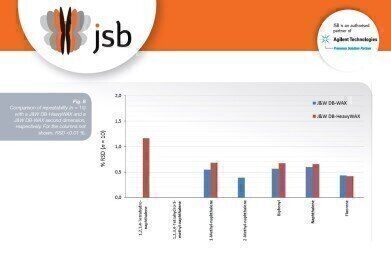GC, MDGC
Using the Agilent J&W DB-HeaveyWAX columns as the second dimenstion in comprehensive 2D chromatography (GCxGC) for the analysis of diesel oil
Mar 27 2019
To provide enhanced separation power and superior peak capacity, GC×GC combines two analytical columns, called dimensions, within one analytical method. Thanks to these unique features, GC×GC has become the method of choice for the detailed characterisation of highly complex samples that cannot be approached with traditional GC. This is the case for many petrochemical products, which are very challenging due to the huge number of compounds covering a wide range of volatilities and chemistries.
From a theoretical point of view, first and second dimensions should have independent separation mechanisms to maximize resolution. In practice, it is accepted that this is not feasible. However, to make best use of the 2D space, phases are generally selected to be as different as possible.
Typical column sets encountered in petrochemical analysis are made of a nonpolar and a midpolar column. The goal is to couple separations based on boiling point and polarity, respectively. Midpolar phases are selected for their ability to separate based on polarity and their wide temperature range. This flexible, robust setup is widely used with good results. Conversely, their separation mechanism is only partially determined by polarity, due to the significant role played by volatility.
In some cases, using a highly polar column with nonpolar phases may be desirable to maximize the role played by polar interactions and improve resolution for specific compounds/groups. In general, WAX type stationary phases are a natural choice for this purpose. These phases are, for instance, very efficient in separating aliphatic and aromatic fractions, and in providing additional separation of the latter into subgroups (for example, mono-/di-/tri-aromatics). However, their use is limited by their low maximum temperature of 240°C.
The J&W DB-HeavyWAX has an extended temperature limit of up to 280°C under isothermal conditions (290°C when programmed). This higher limit permits analysis of higher boiling compounds without risking the integrity of the column. This Application Note examines the use of the J&W DB-HeavyWAX as the second dimension for GC×GC with thermal modulation to obtain extended operational range.
Read the full application note here for the test results and conclusions. Do you want to see and discuss all the solutions JSB has to offer? Visit our European experience centre in the Netherlands! Contact one of our specialists for more information by email.
Author application note: Daniela Peroni, JSBc 2019
Events
Feb 03 2025 Dubai, UAE
Feb 05 2025 Guangzhou, China
Mar 01 2025 Boston, MA, USA
Mar 04 2025 Berlin, Germany
Mar 18 2025 Beijing, China











